Tag: Championing ecological research
Here’s the latest update from our field partners, the Lowland Tapir Conservation Initiative (LTCI) in Brazil. It sounds like the project in the Cerrado is developing well and producing some important and exciting results. Project coordinator, Patricia Medici tells us more:
“At the beginning of the year, we decided to concentrate all our time and energy on getting the Cerrado Tapir Program fully implemented. We’ve been INSANELY BUSY!
“The program has taken off beautifully. In 2015 we only managed to capture two tapirs with just one being old enough to have a radio-collar fit. During our expeditions this year, we managed to capture EIGHT more. Best of all, seven of them were adults and were, therefore, old enough to be radio-collared.
“This takes the total number of tapirs captured in the Cerrado so far to 10; five males and five females, eight adults and two sub-adults. The names of our Cerrado tapirs are: Rafera (sub-adult), Juscelino, Lou, Titi Mahamurda, Roger (sub-adult), Suzanne, Isa, Colombina, Pana and Elis. Many of these tapirs have been named after important supporters for the project from all over the world.
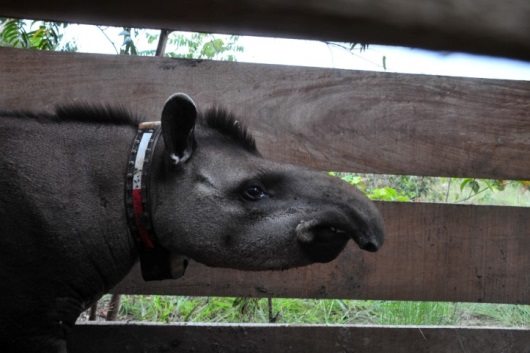
“We are using GPS Iridium technology from Telonics USA – telemetry collars that send data via satellite to my computer at home. We already have tons of data coming in every 2-3 days. This technology is absolutely amazing as it allows us to follow the movements of our tapirs almost in real time. It is fascinating; I have to say I have been completely obsessed with following their movements.
![]() Pati and her team doing some manual radio tracking. Photo credit: The Lowland Tapir Conservation Initiative
Pati and her team doing some manual radio tracking. Photo credit: The Lowland Tapir Conservation Initiative
“We continue to monitor tapir roadkill on seven highways near our study areas in the Cerrado. Since we started monitoring highways in March 2013, we have recorded 110 tapir carcasses, which makes it very clear that roadkill is a truly serious threat to tapirs in the Cerrado. Necropsies – an examination of the body – are carried out right there on the highway with huge trucks flying by, which makes the process even worse. It’s heart-breaking.

The team conducting a necropsy on a roadkill case next to the highway. Photo credit: The Lowland Tapir Conservation Initiative
“Our tapir roadkill data is analyzed regularly and hotspots identified. Our next step is to bring these results to relevant organizations, highway administration departments, and highway concessions among others to start discussions towards mitigating this threat. We are already working with an organisation called WAZE on the development of a map feature that will warn drivers on these highways, particularly truck and bus drivers, about areas of high risk of collision with tapirs in the highways of the State of Mato Grosso do Sul.
“Regarding our tapir health studies in the Cerrado, our preliminary results are showing some very important (and scary) findings. Our first results from toxicological evaluations are showing the presence of heavy metals and pesticides, most probably from sugar cane and soybean plantations. Coincidence or not, we have also found some important macroscopic lesions in liver and kidneys during tapir necropsies. It is well known that pesticides can affect physiological parameters.

Loads of biological samples taken for analysis from necropsies. Photo credit: The Lowland Tapir Conservation Initiative
“We are in the process of mapping sugar cane plantations in the region and holding meetings with environmental conservation departments of sugar cane companies. Some of our monitored tapirs have been found to include sugar cane plantations in their preliminary areas of use and this is an issue we will have to deal with. Sugar cane companies will be an important stakeholder for this project.
 Some tapir dung found in the middle of a fenced sugar cane plantation. Photo credit: The Lowland Tapir Conservation Initiative
Some tapir dung found in the middle of a fenced sugar cane plantation. Photo credit: The Lowland Tapir Conservation Initiative
“In addition, we are getting ready to deal with tapir hunting in the region. We have heard about it happening from several sources. At the moment, we are reviewing literature and consulting with hunting/poaching experts to develop a protocol for the evaluation of tapir hunting in the Cerrado. We will soon be ready to start research which will be most probably based on interviews with members of local communities.”
Keep an eye on our blog for more updates from Pati and the team. In the meantime, why not watch this short video interview we did with Pati when she last visited Chester Zoo.
It’s therefore important that we provide our visitors with opportunities to discover and learn about the biology and conservation of the species found here at Chester Zoo.
Wildlife Conservation is at the heart of everything we do. We use scientific evidence to help identify and address many of the challenges our natural world faces. We aim for our conservation research to help in decision making that improves the management of the animals and plants in our care-influence the sustainability of wild populations and inspire others to be motivated to join us in our challenge to Act for Wildlife.
Through visitor and community engagement we can tell people not only about the animals here at the zoo-but also their conservation status around the world and aim to inspire them to help make a difference – possibly inspire the next generation of conservation scientists!
That’s why we asked the question: “Are interactive activities for zoo visitors effective education tools?”
Due to the vast amount of variability among visitors-investigating the effectiveness of our educational initiatives can be difficult. One of the scientific studies carried out by a member of our discovery and learning team-evaluated the impact of informal learning practices and interactive activities in a zoo environment and identified variables that impact positively on the experience.
Two interactive activities at the zoo were evaluated. Both focussed on two species of critically endangered frog: the mountain chicken and the golden mantella.
Sarah Bazley-learning manager at Chester Zoo-carried out the research – here she tells us more about these amphibian themed activities:
“Although both activities are focussed around conservation efforts of critically endangered frog species-the species are not well known to the majority of visitors; their common names are unusual and don’t obviously describe them.
“There is a selection of field equipment and artefacts for visitors to explore and a member of the zoo ranger team is there to engage and discuss field conservation techniques employed to help each species.
“The mountain chicken activity revolves around the story of field researchers who monitor these frogs in the wild. These researchers microchip the frogs for identification purposes; health check the frogs by weighing and measuring the individuals found; and put transmitter belts on the frogs to track where they are and their survival rates.
“The activity at the zoo uses a number of toy frogs that have been microchipped and weighted. Visitors use the microchip scanner to firstly identify the frogs-then use Pesola scales to weigh and calipers to measure them. Our team also show photos on an iPad showing the researchers using the same equipment and same techniques in the field and there is a prototype of the transmitter belts used on the frogs for visitors to also look at. The zoo ranger is there to engage with visitors and guide the activity around this story.
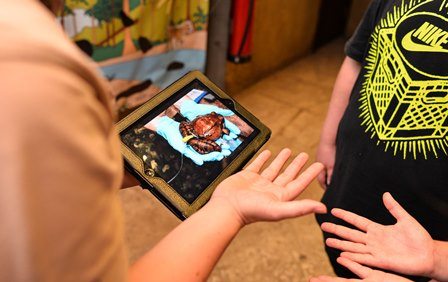
“The golden mantella activity revolves around the story of field researchers who are monitoring the populations of these frogs in the wild. As you may have seen on a previous blog-our conservationists are able to monitor golden mantella populations in Madagascar using an innovative technique of using a silicone implant that glows under UV light.
“The activity we run in the zoo involves a number of toy frogs marked with UV ink-so not obvious to the naked eye-and visitors use a UV torch to identify the marked individuals. A number of transparent toy frogs have been injected with the silicone and the equipment used is there for visitors to look at. Visitors can have their hand stamped with UV ink-and use the torch to reveal a frog outline on their own hand. Photographs on an iPad show the researchers using the same equipment and same techniques in the field-and the zoo ranger is there to engage with visitors and guide the activity around this story.”
Sarah interviewed a number of visitors using a series of open and closed questions designed to explore factors that may impact on informal learning in a zoo environment including; motivation for visit-prior knowledge-what the visitors found out during their visit and knowledge of amphibians and their conservation (in particular the amphibians focussed on in the activity) and awareness of Chester Zoo’s conservation work.
Individuals were interviewed on days the activities weren’t available to act as a control. We found that visitors that engaged with interactive learning activities achieved stronger learning outcomes regarding their knowledge of endangered animals-but little impact was observed regarding knowledge of Chester Zoo’s conservation efforts.
It is possible that this was due to the high awareness already established in most of the visitors. Moreover-those that had visited the zoo with motivations to ‘see the animals’ appeared to gain more from the interactive activities than visitors with alternative motives.
Following the results of this study-recommendations were made to continue using learning and interactive elements to informal learning delivery at the zoo but as there appears to be a particular group of visitors that benefit from interactive learning-activities designed to target specific audiences would be ideal.
Amphibians around the world are threatened by the deadly fungus chytridiomycosis – or chytrid for short. It firstly affects the skin of amphibians which is extremely delicate. But when chytrid invades their skin it disrupts the skins ability to regulate water uptake and causes electrolyte levels to drop. In turn, this makes the amphibians heart stop.
That’s why it’s vital we work together with other scientists, researchers and zoos to develop prevention and mitigation strategies to prevent further declines in frog species.
Molly and colleagues are working to identify the ideal skin probiotics for Madagascar amphibians which we at Chester Zoo are supporting. This work is extremely important in finding a mitigation strategy for the amphibian chytrid fungus.
“The harlequin frog is rapidly becoming Madagascar’s most threatened species. Found only in a handful of very remote sites in the central massif-it has been affected by widespread habitat destruction and collection for the pet trade.

“The species also has the unfortunate luck of being in one of the few places chytrid fungus-a deadly fungus that has wiped out a large proportion of the globe’s amphibian populations-has been identified in Madagascar. With all this stacked against them-the harlequin mantella frogs are trying to adapt to a habitat now devoid of forest-eroded to the point of exposed rock and bathed daily in strong sunlight which raises the temperature to well above their preferred optimum.
“To survive in these conditions the frogs have altered their activity patterns rising before dawn to feed on the moist dew covered rocks before the sun raises the temps too high. As the temperatures rise the frogs retreat underground into fissures cracks and caves amongst the rocks here in the cool moist environment the frogs can be heard calling.
“Here on this altered habitat the MaVoa team get up before the frogs-negotiating the slippery rocks to survey the habitat-each frog is observed before being caught measured and weighed as well as having their bellies photographed as a form of identification.

“Each frog has its own unique pattern of pale blue to white markings on a jet black belly making them identifiable without the need for elastomer injections or microchips.
“Over the time I was there the team identified 50 plus individuals-however twelve months previous the number had been almost triple that!
“This decline is not fully understood-over the last few years surveys have not revealed any signs of active reproduction at the site and although the frogs could easily be reproducing in the network of underground caves this has not been confirmed.

“The team were heading to a second site where the habitat is less altered. Previously-at this site the team had found small numbers of frogs-however this year’s survey revealed not a single frog over a two week period of intense searching. The future for this species is not looking good at all…
“My role whilst I was there was to set up and deposit data loggers across the site to collect environmental data from the exposed rock faces-the caves and crevices and the few small streams and rivulets nearby. This data will be used to create a picture of the habitats utilised by this species-in the hope we can recreate the niches needed by the frogs in case a time comes when the frogs have to be taken in to captivity to prevent their total extinction.”
We will be sure to continue updating you on the progress of the work we’re doing in Madagascar. Follow us on Twitter–like us on Facebook or join us on Instagram to keep up to date with all the latest Act for Wildlife news and updates!
We will continue to Act for Wildlife and fight for amphibians like the golden mantella and harlequin frog species.
“Having trekked out of Mangabe forest-we were met by Ta one of Madagasikara Voakajy’s (MaVoa) 4×4 drivers who was going to be my travelling buddy for the next part of my trip. We loaded our gear into his sparkly clean vehicle and set off to return to Moramanga with the team…and four chickens!
“After a very bumpy hour we were back at the MaVoa office in Moramanga. Here we said goodbye to the Mangabe field team and Luiza as Ta and I headed off to the Project Mitsinjo field station.
“Here-a population of 300 plus golden mantellas are maintained having been rescued from the site of the Ambatovy mine prior to its operation. These frogs are intended to be maintained for three to five years whilst a new habitat is identified and given a protected status.
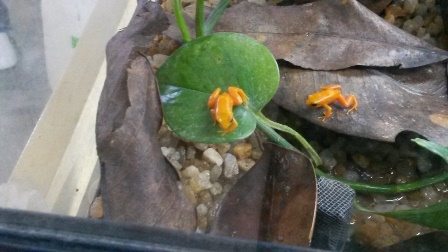
“The work in Mangabe forest is helping us identify key features about mantella habitat to help with the identification of a possible mitigation site for these homeless frogs. Our job for the next few days was to liaise with the team in Mitsinjo-exchange experiences of golden mantella husbandry and collect data relating to the health and suitability of the frogs for release. This data would then be compared to the data collected in Managbe as well as zoo populations in the UK-including Chester Zoo’s large population of frogs.
“That evening we returned to the hotel before setting out on a night walk with an official National Park guide-the tour takes place along the main road as access to the park at night is forbidden-however part way along the road is a free orchid garden and here you can walk through the forest edge spotlighting the nocturnally active wildlife. Here we saw sleeping chameleons-frogs and geckos as well as the tell-tale eye shine of distant lemurs.
“As we were about to finish the walk-the guide spotted four eyes high above us and when the lights were focused in the right place-a pair of crossleys furry eared dwarf lemurs came into view. My first-and as it turned out only-lemurs I saw in Madagascar (unlike the Chester Zoo Madagascar expedition team)!
“We rose early the next day to begin work at the Mitsinjo frog facility. We processed around fifty frogs which were a combination of those collected from the mine site and frogs bred and reared in the facility.
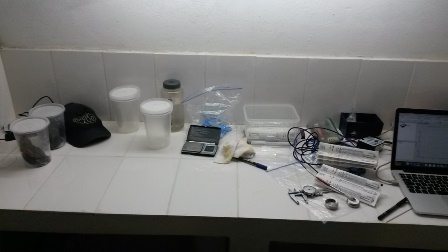
Working at the Mitsinjo frog facility – exchanging experiences of golden mantella husbandry
“The following day I was to join up with Christian from MaVoa to visit the site of the second species of mantella the zoo is helping to protect: the harlequin mantella.”
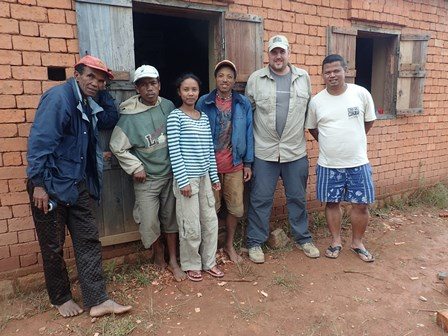
Find out more about the harlequin mantella and the work we’re doing with MaVoa by reading the final part of ‘Mangabe or bust’ on our blog tomorrow.
“Day two started much like day one but the rain over the afternoon and night had caused the river to rise even more which had a knock on effect for the rest of the day. To get to the study site for the day-we would normally have waded through a shallow part of the river. Unfortunately this was not really very shallow anymore-in fact-it looked more like a white water rafting course than a crossing point-so a detour had to be made.
“The detour led us in a large arc into the forest where we came to a small bridge… well it was more like a log under water in which you had to use a stick to help you balance! Or not in my case – it wasn’t long before I fell off the log and straight into the water – I was totally soaked through.
“At this point I felt thoroughly like an explorer and pressed on-when a combination of screaming and swearing erupted about 10metres ahead of me. Gilberto (the only one who knew what was going on) grabbed me and dragged me sideways 20 metres before continuing onwards then back to path. He had navigated us around what turned out to be a wasp nest that had been disturbed by one of the guides. The number of casualties wasn’t too high and after a few moments of excruciation-the pain passed and we continued to the site. Once at the site myself and Wayne began setting up more quadrats whilst Luiza and the field team started collecting the 40 frogs she needed to scan as part of her PhD.
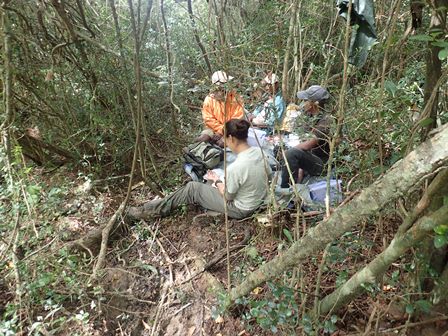
“Luiza is looking into the health and fitness of captive animals compared to wild specimens. With the data collected we began our trek back-which-to be honest I wasn’t really looking forward to. Gilberto decided we’d head farther inland and try our luck at getting out via one of the large rice paddies nearby. This proved to be less eventful than the journey in but a little slower as a result of traversing the 10cm wide banks of the paddy fields-a little like walking on a tightrope. Eventually we made it to solid dry ground and as a reward the sun came out briefly as we walked back.
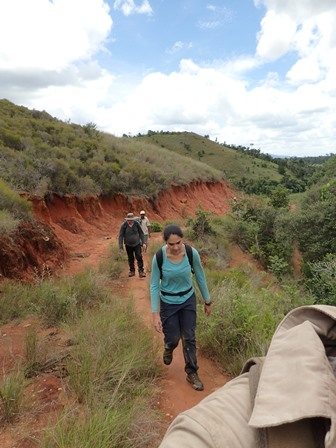
“On day three-the whole team headed to our second ‘mark and release’ site which was happily much closer to camp than the first and required only one small river crossing and a bit of wading. On our way we saw lots of Mantellas as well as Madagascan jumping frogs and warty bright eyed treefrog. Again we set up a bit of a base for the data collection and the team vanished off into the forest to return with boxes of mantellas for us to process.
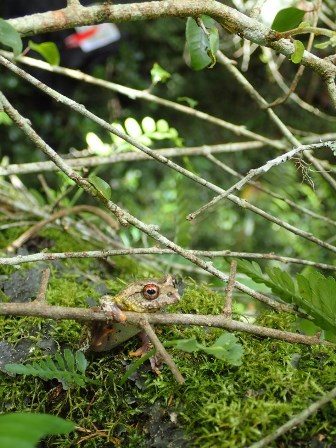
“We revisited each of the sites a further two times repeating the data collection whilst encountering a few more of Madagascar’s herpetofauna including leaf chameleons-carpet chameleons and Madagascan hognose snakes.”
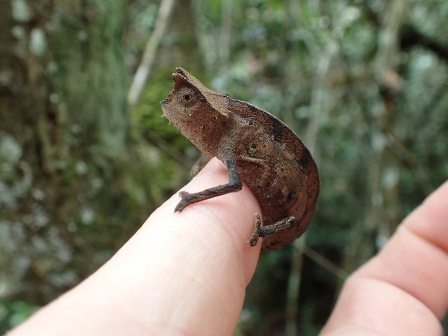
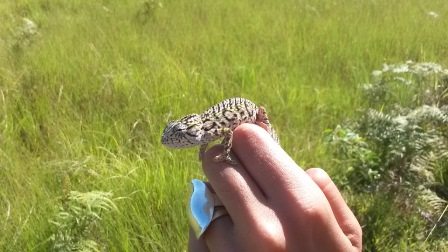
Can’t wait for part 3 (which will be on our blog tomorrow)? Then you can find out more about the work we’re doing with Madagasikara Voakajy here.
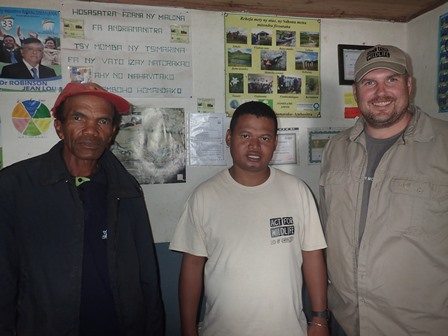
Ben Baker (right) with members of the MaVoa team
As well as working closely with Chester Zoo conservation scholar-Luiza Passos-on her research with golden mantellas-Ben has also been working closely on the long-term frog surveys being carried out in the Mangabe forest over a two year period; activities that the Chester Zoo expedition team also contributed towards earlier this year.
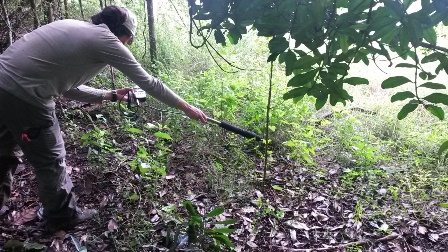
Each golden mantella study has three periods: we monitor the frogs in November-then again in January (which is breeding season) and again in March. This has been done over a couple of years in order to build up a solid base of data.
Here Ben tells us more about his last visit to Madagascar which took place last year:
“Back in 2013-Chester Zoo began a research project into the effectiveness of elastomer marking techniques for identification in golden mantellas (basically tiny silicone tattoos).
“This initially started by marking ten and two months later-with no signs of problems arising-we began to mark the remaining 60! Over the following year-we monitored them to see if the elastomer marking had affected their breeding capabilities-their ability to hunt and their movements within their enclosures as well as our ability to identify the different batches of marked frogs.
“The reason for all this monitoring was to make sure we knew the limitations of the marking before it was used on wild populations. The technique would be being used in Madagascar with one of the last remaining populations of golden mantellas. The resulting study would help us make informed decisions as to possible sites for translocations of frogs from threatened habitats.
“Our study population of mantella is found in the Mangabe forest. At the beginning of 2015-very early in the morning-I began my journey to assist Madagasikara Voakajy’s (MaVoa) herpetology team with the second survey of the area focussing specifically on four breeding ponds.
“The trip started slowly and 11 hours later I arrived at Antananrivo airport and along with Luiza Passos. Waking up at 7am the following day I was greeted with bright sun streaming through the shutters and what looked like an amazing first day in Madagascar. Packing up-we headed across town for a planning meeting at the MaVoa offices before preparing for our drive into Mangabe forest.
“After packing the van with all our equipment and supplies for the two and a half weeks the team would be in the forest-our driver-Christian-Wayne Edwards from Paignton zoo/DICE-Luiza Passos-myself-Eddie Rakotondrasa-Gilbertho Canova Randrianatenaina, Fandresy Tefinanaharinnoro-as well as local guide and four chickens-all climbed into the vehicle for the drive. Yes-that’s right-eight people in a four seater four-wheeled-drive!!
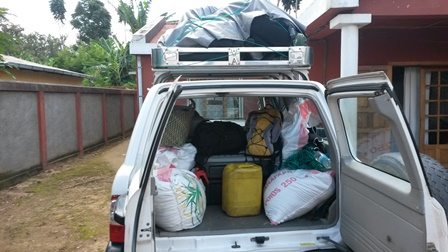
“About 30mins into the drive-we were faced with our first logistical issue; a broken down truck blocking the road…from this point on we had to walk. After a further two hours trekking we reached our destination-next to a large river away from the forest. Here we set up camp for the next 11 nights. Just before our tents were properly erected it began to rain-heavily. And it rained solidly for the following twelve hours; so hard that when we woke up the following day the river was considerably higher!
“Waking up with the sunrise at 5.30am was to become the standard. This would be followed by putting on slightly damp clothes before enjoying a hearty breakfast of rice…lots of rice. Sometimes with small dead mosquito fish and snails on it (my least favourite meal of the trip).
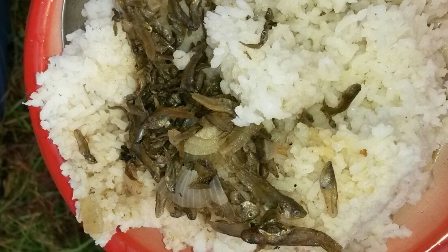
“With breakfast over we would then trek to the study site. On the first day this was Bejofo pond in Mangabe forest. Even whilst walking along the ‘road’ towards the forest-we had started to see golden mantellas hopping across the path and foraging for food. Once we got to the pond the noise of mantellas calling was everywhere and the frogs were easily visible amongst the leaf litter around the pond.
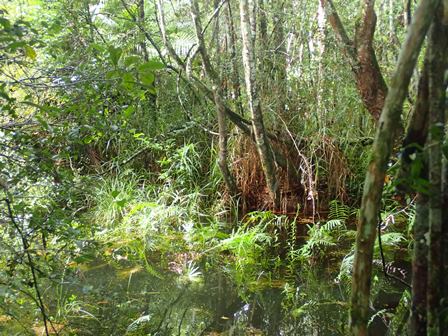
“There were even tadpoles in the pond and the tributaries that fed to it. We setup up a makeshift base and the guides and MaVoa team started to collect frogs from the transects established in November 2014. These were then brought to the base and we started checking them for existing elastomer markings from the November trip-as well as taking morphometric data (weight-length etc) and then marking any animals with no marker – this time in a different leg and with a different colour.”
“I arrived at cedar house at 2.30 in the morning bag packed and ready to go; from Manchester we took a quick flight to Paris and then a 12 hour flight to Madagascar.
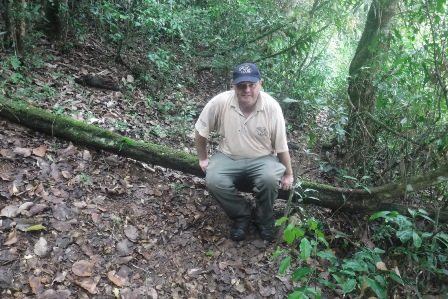
“I didn’t know what to expect and where the adventure lying ahead of me was going to take me but I knew that the four months I had spent training in the gym would help.
“As soon as we landed in Madagascar and the plane doors opened-I could feel that it was going to be a hot and humid trip. It took us a while to get through customs as we had 21 bags of luggage with us! Finally-we arrived at our hotel in Tana around 2am to get some much needed sleep.
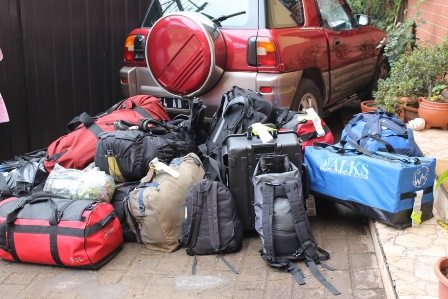
“The next day-we all piled into the Land Rover and set off to the base camp that was going to be our home for the next couple of weeks and was located in the middle of nowhere. What a journey! We got stuck in mud and bounced around a lot in the back of the car but we finally made it to a clearing.
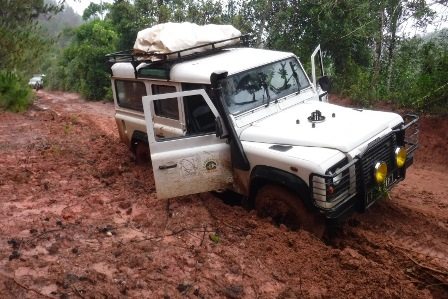
“We got out of the cars-unloaded our bags and came across our next obstacle: a river we needed to cross. How were we going to do this?
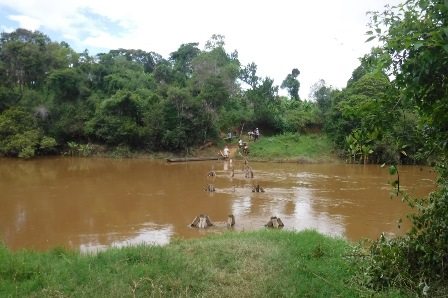
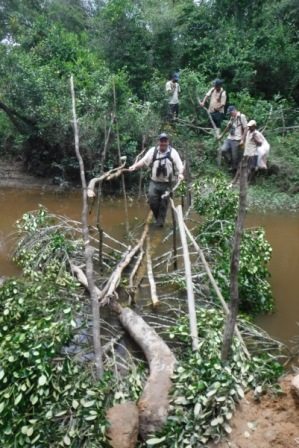
“A bloke in a hollowed out tree floated towards us and yes-that was the boat that we were going to use to cross the river. Following our boat ride-it was a hot and sticky 40 minute walk to camp but what an amazing place!
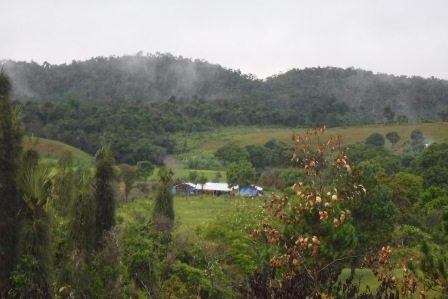
“It was hard work walking an hour and a half through the forest and swamp like land to the survey site on a daily basis.
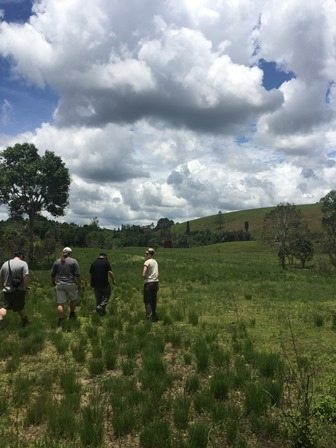
“I also now hate rice after eating rice for breakfast-dinner and tea every day. I really enjoyed every minute in the forest. Chester Zoo are doing fantastic work in Mangabe with Madagasikara Voakajy working together on their conservation community projects.”
Chester Zoo’s golden mantella frogs are playing an increasingly important role in conservation as their species is critically endangered in the wild. The reintroduction of endangered species into their natural habitat has sometimes proved difficult – it’s not just as simple as putting them back in the wild.
By evaluating the ‘fitness’ of the zoo population of golden mantella we can then improve the success of reintroduction attempts. Chester Zoo Conservation Scholar Luiza Passos is a PhD student at the University of Salford. She has been working closely with our curator of lower invertebrates and invertebrates, Gerardo Garcia, and team manager of lower vertebrates and invertebrates, Ben Baker, to evaluate the population of golden mantella at the zoo.
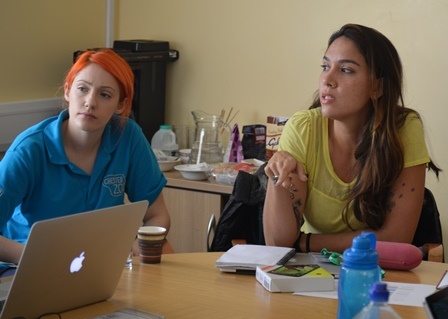
Luiza Passos (right) at Chester Zoo discussing her research with staff
Their research involves measuring the characteristics of golden mantellas, such as color patterns, vocalisation, body condition and behaviour at the zoo, and comparing this to the information gathered in the field in Madagascar. The aim is to increase our understanding of where conditions can be enhanced to ensure optimal fitness for future in-situ generations of golden mantella.
Below Luiza tells us more about her research:
“In zoo conservation breeding and reintroduction is becoming a high profile conservation tool for many species threatened with extinction. However, before reintroducing any species back into the wild, research is needed to help make more informed decisions and improve the success rate.
“The reintroduction of endangered species into their natural habitat has proved difficult. If animals are to be released into the wild these questions need to be addressed. With this in mind I decided to target my PhD research on measuring the characteristics of golden mantellas at the zoo and comparing these to the information gathered in the field in Madagascar.”
The aim of Luiza’s research is to increase our understanding of where conditions can be enhanced even further to ensure optimal fitness for future in-situ generations of golden mantella and increase the success of reintroduction programmes.
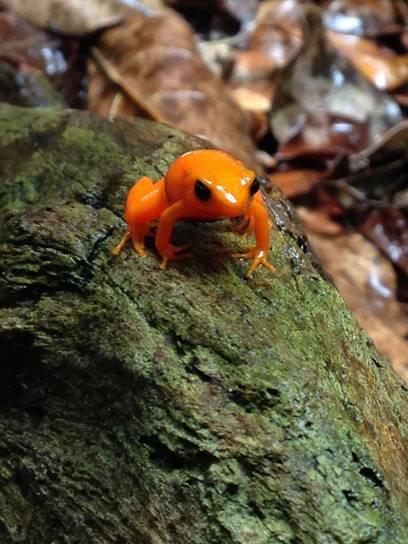 Golden mantella frog. Photo credit: Luiza Passos
Golden mantella frog. Photo credit: Luiza Passos
“The species I focused my research on is the golden mantella frog (Mantella auriantaca) from Madagascar. These amazing little creatures are endemic to Madagascar and are currently considered by the IUCN Red List as ‘critically endangered’ due to habitat destruction (mainly mining) and over exploitation for the pet trade market. Reintroduction is one of the many conservation tools described on the species’ conservation action plan to help save it from extinction in the wild.
“I will be analysing a variety of characteristics that are crucial for the survival of golden mantellas in the wild such as:
Skin coloration – this is important for finding a mate and keeping predators away.
Skin microbiota – this is a measurement of their immune system capabilities.
Vocalisations – this is important for attracting a mate.
Body condition – this shows how healthy individuals are.
“Data from a healthy wild population is being used as a baseline for comparison with a variety of populations in the UK and Madagascar. I have already had the opportunity to go to Madagascar twice in for fieldwork to collect data from a wild population. Field work in Madagascar is a truly amazing experience; waking up each day to the sound of indri lemurs and seeing all these tiny orange frogs hoping around the forest floor is just beyond words! The fieldwork is done in partnership with Chester Zoo’s project partners Madagasikara Voakajy.
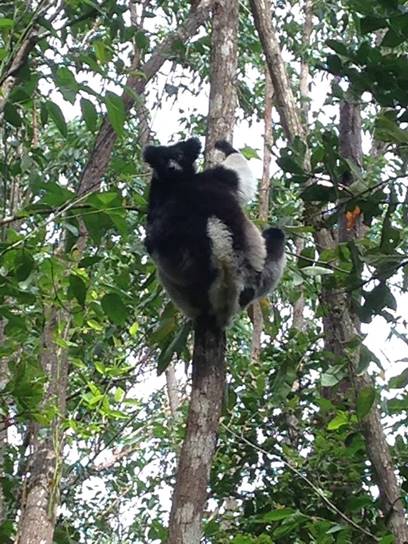 Indri lemur. Photo credit: Luiza Passos
Indri lemur. Photo credit: Luiza Passos
“On my second trip to Madagascar I also had the opportunity to visit Andasibe and collect data from a conservation breeding centre at the Mitsinjo Association. Housed at Mitsinjo is a founder population of golden mantellas and their first offspring as a genetic resource, or safety net population, for future reintroduction programmes.
“In addition to fieldwork in Madagascar I have also been collecting data from the population at Chester Zoo to be compared with wild and Mitsinjo’s animals. At the moment I am analysing all the data I have collected from all these different populations to be able to understand when reintroduction would be a viable option for this species. I already have some preliminary data, which shows some reassuring results, such as the fact that the Chester Zoo population is very healthy. There is still a lot of work to be done in my PhD before I have some definitive conclusions. I’ll keep you updated with progress of my research.”
If you want to hear more from Luiza and learn more about her PhD work – which is funded through a scheme based in Brazil called ‘Science without Borders’ – watch this video created by the University of Salford.
We’re working in Madagascar, with our partners Madagasikara Voakajy (MaVoa), on a number of vital projects to help safeguard the diverse range of wildlife on this unique island.
A team of Chester Zoo staff spent two weeks in the remote Mangabe forest with the MaVoa team. The below video shows you just some of the activities they got up to and how we’re helping to protect the amazing wildlife found in this part of the world.
Want to find out more about the work we’re doing in Madagascar and hear from members of the expedition team? Take a look at our blogs here.
You can Act for Wildlife by supporting our amphibian conservation work by texting ‘AMPH18 £5’ to 70070 to donate £5 now (JustTextGiving by Vodafone*). Alternatively you can make an online donation here.
* Our Text to Donate service is delivered through Just Giving. Texts are charged at your mobile phone operator’s standard rate. We will receive 100% of your donation. You MUST be 16 or over and must have the bill payer’s permission. For full Terms of Service please visit Just Giving.